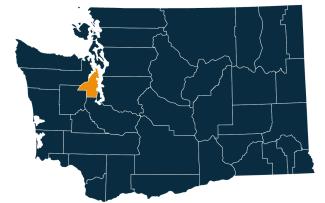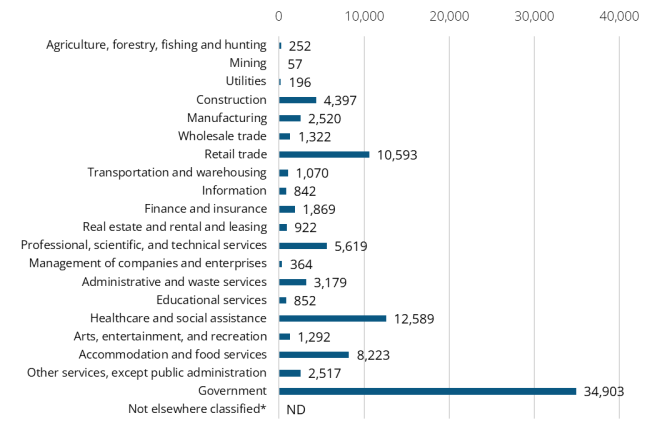- Posted December 2025
September 2025 highlights
Since August, the not seasonally adjusted unemployment rate decreased to 3.7% from 4.3%, and total nonfarm employment was down 300 jobs.
Summary
The not seasonally adjusted unemployment rate was 3.7% in September 2025, down from 4.3% in August 2025 and down from 3.8% in September 2024. Kitsap County’s labor force had an estimated 122,539 workers in September 2025. Total nonfarm employment, at 96,200 jobs, was 300 jobs lower over the month and was 600 jobs below the same time last year.
Location

Kitsap County is the northern end of the Kitsap Peninsula, jutting into the Puget Sound between the Olympic Peninsula to the west and King County to the east. It is between Hood Canal and Admiralty Strait. Water transportation is dominant in the culture and economy. The county seat is Port Orchard.
Kitsap County is one of the smallest counties in the state in terms of land area at about 395 square miles. It ranks third, however, in the state in terms of its population density, with 750 people per square mile.
Kitsap County is synonymous with the Bremerton-Silverdale Metropolitan Statistical Area (MSA). Kitsap County is part of the Olympic Workforce Development Area. Visit the Workforce Training & Education Coordinating Board website for information about the 12 regions.
Employment situation for September 2025
Labor force and unemployment
-
The not seasonally adjusted unemployment rate was 3.7% in September 2025, down from 4.3% in August 2025 and down from 3.8% in September 2024.
-
The estimated labor force was 122,539 workers, up 1,597 workers over the month and 2,193 workers above September 2024.
Unemployment rate, not seasonally adjusted

Source: Employment Security Department/Labor Market Information and Research Division, Local area unemployment statistics
Payroll employment
-
Total nonfarm employment was estimated at 96,200 jobs in September 2025, 300 jobs lower than last month and 600 jobs below the same time last year.
-
Goods producing industry employment was down 100 jobs over the month and down 100 jobs from the same time last year.
-
Service providing industry jobs were down by 200 jobs over the month and down by 500 jobs from the same time last year.
-
Professional and business services industry jobs were down 100 jobs over the month and were 800 jobs below last year.
-
Leisure and hospitality were 200 jobs below last month and 200 lower than last year.
-
Government jobs were up 300 jobs over the month and were up by 100 from the same time last year.
Nonfarm employment estimates, not seasonally adjusted, Kitsap County
| NAICS Industry Title | Sep 2025 (Prelim) | Aug 2025 (Revised) | Sep 2024 (Revised) | Aug 2025 to Sep 2025 Change | Sep 2024 to Sep 2025 Change | Sep 2024 to Sep 2025 % Change |
|---|---|---|---|---|---|---|
| Total nonfarm | 96,200 | 96,500 | 96,800 | -300 | -600 | -0.6% |
| Total private (total nonfarm less government) | 61,400 | 62,000 | 62,100 | -600 | -700 | -1.1% |
| Goods-producing | 7,400 | 7,500 | 7,500 | -100 | -100 | -1.3% |
| - Mining, logging and construction | 4,700 | 4,800 | 4,900 | -100 | -200 | -4.1% |
| - Manufacturing | 2,700 | 2,700 | 2,600 | 0 | 100 | 3.8% |
| Service-providing | 88,800 | 89,000 | 89,300 | -200 | -500 | -0.6% |
| - Trade, transportation, and utilities | 13,300 | 13,400 | 13,500 | -100 | -200 | -1.5% |
| - - Retail trade | 10,600 | 10,600 | 10,800 | 0 | -200 | -1.9% |
| - Professional and business services | 9,000 | 9,100 | 9,800 | -100 | -800 | -8.2% |
| - Leisure and hospitality | 9,600 | 9,800 | 9,800 | -200 | -200 | -2.0% |
| - Government | 34,800 | 34,500 | 34,700 | 300 | 100 | 0.3% |
Note: Data benchmarked through March 2025, updated December 8, 2025.
Source: Employment Security Department/Labor Market Information and Research Division, Washington employment estimates (WA-QB & CES)
Detailed tables can be found on the source page in the third spreadsheet titled Current employment estimates, not seasonally adjusted.
Industry employment (covered employment)
Employment by industry, Kitsap County 2024 annual average

Source: Employment Security Department/Labor Market Information and Research Division, Covered Employment (QCEW)
Average annual covered employment in Kitsap County was 93,579 workers in 2024. Covered employment refers to state workers covered by state unemployment insurance (UI) laws and federal workers covered by the federal unemployment compensation program.
Top sectors in terms of employment in 2024:
- Government (34,903)
- Health care and social assistance (12,589)
- Retail trade (10,593)
- Accommodation and food services (8,223)
- Professional, scientific and technical services (5,619)
The average annual wage in Washington state for all industries was $92,467in 2024. The average annual wage in Kitsap County for all industries was $71,573 in 2024.
Top sectors in terms of average annual wages in 2024:
- Information ($146,394)
- Utilities ($123,380)
- Management of companies and enterprises ($103,371)
- Professional, scientific and technical services ($102,070)
- Finance and insurance ($96,885)
Workforce demographics in Kitsap County
Age
| Demographic characteristic | Total | Labor force participation rate | Unemployment rate |
|---|---|---|---|
| Population 16 years and over | 227,461 | 61.9% | 4.8% |
| 16 to 19 years | 11,552 | 44.0% | 18.9% |
| 20 to 24 years | 19,485 | 89.5% | 8.2% |
| 25 to 29 years | 19,980 | 82.9% | 5.0% |
| 30 to 34 years | 20,072 | 81.0% | 4.6% |
| 35 to 44 years | 36,023 | 83.1% | 3.9% |
| 45 to 54 years | 30,759 | 78.7% | 3.0% |
| 55 to 59 years | 18,392 | 72.2% | 3.4% |
| 60 to 64 years | 18,333 | 54.6% | 3.0% |
| 65 to 74 years | 32,537 | 20.7% | 5.9% |
| 75 years and over | 20,328 | 6.3% | 1.5% |
Race or Hispanic origin
| White alone | 178,473 | 60.4% | 4.6% |
|---|---|---|---|
| Black or African American alone | 5,853 | 70.9% | 1.9% |
| American Indian and Alaska Native alone | 2,276 | 63.8% | 4.4% |
| Asian alone | 11,795 | 61.7% | 4.0% |
| Native Hawaiian and other Pacific Islander alone | 1,976 | 57.7% | 4.5% |
| Some other race alone | 5,523 | 74.2% | 5.0% |
| Two or more races | 21,565 | 69.1% | 7.8% |
| Hispanic or Latino origin (of any race) | 17,894 | 71.6% | 5.7% |
| White alone, not Hispanic or Latino | 172,926 | 59.8% | 4.6% |
| Population 20 to 64 years | 163,044 | 78.3% | 4.2% |
Sex
| Demographic characteristic | Total | Labor force participation rate | Unemployment rate |
|---|---|---|---|
| Male | 86,143 | 86.2% | 4.2% |
| Female | 76,901 | 69.5% | 4.3% |
Females with children
| Demographic characteristic | Total | Labor force participation rate | Unemployment rate |
|---|---|---|---|
| With own children under 18 | 26,645 | 65.8% | 3.4% |
| With own children under 6 only | 7,524 | 59.8% | 3.6% |
| With own children under 6 and 6 to 17 | 4,940 | 56.8% | 5.1% |
| With own children 6 to 17 only | 14,181 | 72.2% | 2.8% |
Poverty status in the past 12 months
| Demographic characteristic | Total | Labor force participation rate | Unemployment rate |
|---|---|---|---|
| Below poverty level | 13,119 | 42.1% | 19.1% |
| At or above the poverty level | 145,050 | 81.2% | 3.5% |
Disability status
| Demographic characteristic | Total | Labor force participation rate | Unemployment rate |
|---|---|---|---|
| With any disability | 18,965 | 50.3% | 10.6% |
Educational attainment
| Demographic characteristic | Total | Labor force participation rate | Unemployment rate |
|---|---|---|---|
| Population 25 to 64 years | 143,559 | 76.8% | 3.8% |
| Less than high school graduate | 6,862 | 56.5% | 8.4% |
| High school graduate (includes equivalency) | 31,765 | 71.0% | 6.5% |
| Some college or associate's degree | 54,335 | 76.9% | 3.0% |
| Bachelor's degree or higher | 50,597 | 83.0% | 2.7% |
Source: U.S. Census Bureau, American Community Survey 5-year estimates, S2301 | Employment Status
This workforce product was funded by a grant awarded by the U.S. Department of Labor's Employment and Training Administration. The product was created by the recipient and does not necessarily reflect the official position of the U.S. Department of Labor. The Department of Labor makes no guarantees, warranties, or assurances of any kind, expressed or implied, with respect to such information, including any information on linked sites and including, but not limited to, accuracy of the information or its completeness, timeliness, usefulness, adequacy, continued availability, or ownership. This product is copyrighted by the institution that created it. Internal use by an organization and/or personal use by an individual for non-commercial purposes is permissible. All other uses require the prior authorization of the copyright owner.

